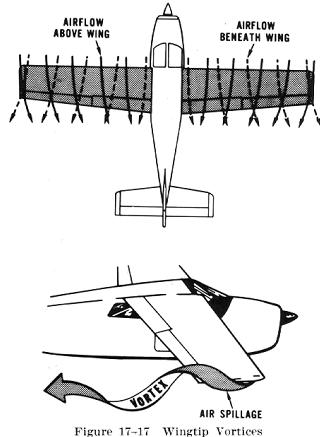Wingtip Vortices
| As we have already learned the action of the airfoil that gives an
airplane lift also causes induced drag. The explanation of this was
discussed in preceding sections of this chapter. It was determined that
when a wing is flown at a positive angle of attack, a pressure
differential exists between the upper and lower surfaces of the wing; that
is - the pressure above the wing is less than atmospheric pressure and the
pressure below the wing is equal to or greater than atmospheric pressure.
Since air always moves from high pressure toward low pressure, and the
path of least resistance is toward the airplane's wingtips, there is a
spanwise movement of air from the bottom of the wing outward from the
fuselage around the wingtips. This flow of air results in "spillage" over
the wingtips, thereby setting up a whirlpool of air called a "vortex"
(Fig. 17-17). At the same time the air on the upper surface of the wing
has a tendency to flow in toward the fuselage and off the trailing edge.
This air current forms a similar vortex at the inboard portion of the
trailing edge of the wing, but because the fuselage limits the inward
flow, the vortex is insignificant. Consequently, the deviation in flow
direction is greatest at the wingtips where the unrestricted lateral flow
is the strongest. As the air curls upward around the wingtip it combines
with the wing's downwash to form a fast spinning trailing vortex. These
vortices increase drag because of energy spent in producing the
turbulence. It can be seen, then, that whenever the wing is producing
lift, induced drag occurs, and wingtip vortices are created. |
|
Just as lift increases with an increase in angle of attack,
induced drag also increases. This occurs because as the angle of attack is
increased, there is a greater pressure difference between the top and bottom of
the wing, and a greater lateral flow of air; consequently, this causes more
violent vortices to be set up, resulting in more turbulence and more induced
drag.
The intensity or strength of the wingtip vortices is directly
proportional to the weight of the airplane and inversely proportional to the
wingspan and speed of the airplane. The heavier and slower the airplane, the
greater the angle of attack and the stronger the wingtip vortices. Thus, an
airplane will create wingtip vortices with maximum strength occurring during the
takeoff, climb, and landing phases of flight.
 |
FAATest.com
- Aviation Library
Dauntless
Software hosts and maintains this library as a service to pilots
and aspiring pilots worldwide. Click
here for ways to show your appreciation for this service.
While much of this material comes from the FAA, parts of it are (c) Dauntless Software, all rights reserved. Webmasters: please
do not link directly to individual books in this library--rather,
please link to our main web page at www.dauntless-soft.com or
www.faatest.com. Thanks! |
|

